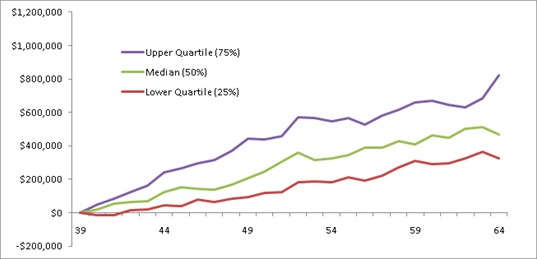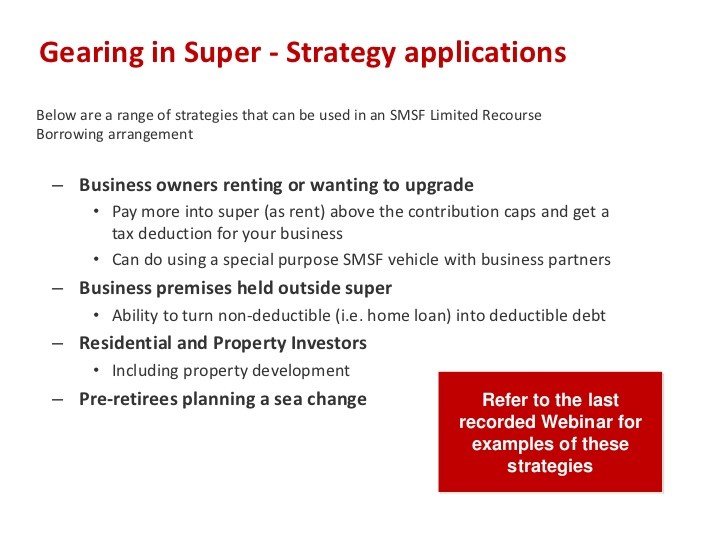How to borrow to invest more in super
Post on: 16 Март, 2015 No Comment

Article utilities
Contributing money to super within the tax concessional contribution limits will build your retirement savings in a tax-effective way. Instead of paying tax at your personal tax rate, concessional contributions are included in the assessable income of the fund where they attract a 15 per cent tax rate.
Watch out for tax
Exceeding the contribution limits will also build your savings but in a less tax-effective way. In addition to the fund paying 15 per cent income tax on the total contribution, the excess amount is personally taxed at an additional 31.5 per cent, meaning a total 46.5 per cent tax can apply.
A reader writes: Ive noticed comments in some recent articles that one of the advantages of borrowing to invest is that it allows you to increase your contributions, presumably above the tax concessional thresholds. Could this strategy be more fully explained?
Supers tax concessional limits for the 2011-12 financial year are $25,000 where a fund member is under age 50 on June 30 and $50,000 if they are 50 or older on this date. The usual practice with contributions is to make investments with the after-tax proceeds.
A $50,000 contribution becomes $42,500 after the 15 per cent income tax is deducted, and this money can then be committed to investments which will hopefully enhance contributions with investment returns. This becomes the funds investment capital.
Three types of gearing
When you borrow money to invest, says senior technical manager Craig Day of Colonial First State, you employ a strategy described as gearing to increase the funds investment capital.
Gearing can be positive, neutral or negative. How it is described depends on the level of income produced by the geared investment compared with the gearing expenses, which are mainly the interest borrowing costs.
Positive gearing is when investment income exceeds the costs of borrowing while neutral gearing is when income equals expenses.
Negative gearing results when the investment income is less than the interest costs. While negatively geared investments outside super need to be supplemented from other income such as an investors wages or salary, a negatively geared DIY fund investment must either make extra contributions or divert income from other fund investments.
Profits and pitfalls
With a geared investment it is crucial the fund makes an overall profit, although a strategy can be profitable if the value of the investment increases and the borrowings either remain constant or reduce only slightly. A negatively geared investment then becomes neutral or even positively geared.
Although its not recommended and considered to be a fringe strategy given there are other potential pitfalls where a fund is in an overall negative position, says Day, one way of dealing with this is to make excess tax concessional contributions up to the negative position.
If a fund, for instance, is negatively geared overall to the tune of $10,000 meaning the interest expenses are $10,000 greater than the total fund income the members could risk an excessive $10,000 concessional contribution. So a $60,000 contribution could be made on behalf of a 55-year-old member, where $50,000 is the contribution limit amount and $10,000 an excess contribution.
The attraction in this strategy is that $60,000 is fully tax deductible to the contributor, whether it is an employer contribution enhanced by a salary sacrifice amount or a personal tax deductible contribution. In super, no limits apply at the contributor level which means all concessional contributions are fully tax-deductible irrespective of the amount.
Where the excessive treatment applies is at the individual member level. This is where the $25,000 cap or the $50,000 cap applies depending on whether you are not yet 50 or 50 and over.

Reducing the tax bill
Although it is commonly stated that tax of up to 46.5 per cent can be levied on contributions with an excessive amount, this level of tax may also be limited to 31.5 per cent. This can occur where a fund has a borrowing arrangement in which the interest expense exceeds the funds investment income: in other words where the overall fund is negatively geared.
In this case, says Day, the fund could use the excess deductions to reduce the excess concessional contribution included in the funds taxable income. Whereas if it didnt have excess deductions, the full $60,000 would be treated as assessable income and taxed at 15 per cent, a $10,000 deduction will reduce the assessable income to $50,000.
This highlights an interesting aspect of tax on super contributions. Although it is commonly stated that super funds pay a 15 per cent contributions tax, says Day, there is no separate contributions tax as such. Tax-concessional super contributions are included in the assessable income of the fund and can be reduced by deductions.
While it may be possible to reduce the 15 per cent tax on assessable income, says Day, one thing that cant be avoided is the 31.5 per cent tax on amounts above the contributions limit. In this case, its the individual member who must pay this tax, either personally or they can withdraw it from their fund. On a $10,000 excess amount, this represents $3150 of tax payable by the member.
Beware
Although it comes across as a way of making a concessional contribution greater than the concessional limit, the strategy does require the fund to be negatively geared. If it is not, then the total fund contribution including any amount above the cap will be taxed at 15 per cent with the excess amount taxed at a further 31.5 per cent. This gives a combined amount equal to the top personal tax rate.
Furthermore any excess concessional contributions, including the tax that must be paid, will count in full towards the non concessional contribution limit.
Day cautions that entering into any strategy that involves deliberately exceeding a contribution cap requires a thorough understanding of the contribution limit rules. as exceeding the concessional cap could also cause a member to exceed their non-concessional limit which could then result in some terrifying tax penalties much greater than the top personal tax rate.














